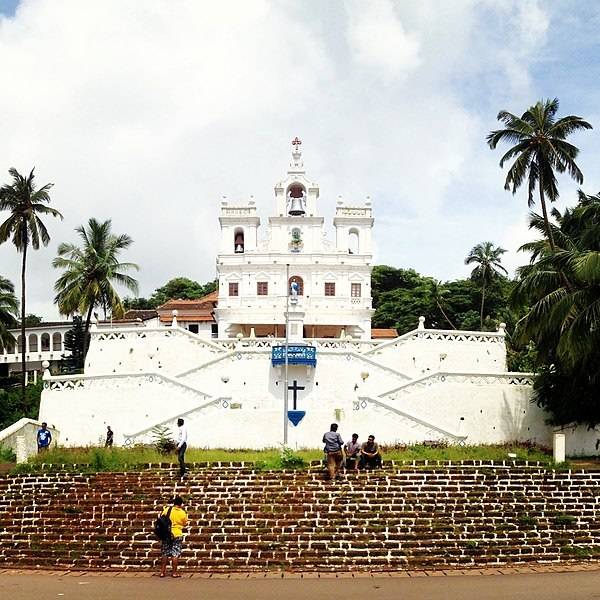By Jyoti Dhond
She has been overseeing Panaji city for 413 long years. Witnessed revolts, rallies, strikes, film shootings, processions, feasts, and whatnot. Atop a hillock on the way to Altinho in Panaji, where Portuguese soldiers once stopped to worship. Built as a small chapel in 1541 and later on was bestowed the honor of being a church in 1609. In the 18th century, the symmetrical zig-zag stairway was added to it, giving its architecture a further uplift. Yes, you guessed it right. It’s the iconic Church of Our Lady of Immaculate Conception at Panaji.(Igreja de Nossa Senora da Immaculada Conceicao)
Painted in pristine white and cool blue. Colours that soothe the eye and bestow peace within as one climbs the steps onwards to the church. This Church fits the capital city of Panaji like an ancient crown. The church standing tall and proud has its own history as well. The Baroque architecture-styled church was built by the Portuguese in the year 1609. Earlier it was a small chapel. The site was once a landing port during the Portuguese regime in Goa.
The Church houses an ancient bell that was removed and fitted here in 1871 from the ruins of Church of Our Lady of Grace at Old Goa. It is the second largest bell in Goa , next to the golden bell in Se Cathedral in Old Goa. The giant bell at the centre and amidst two pillars throws its arms open as if to welcome every worshipper. The resonance of the bell during daily Masses sing the songs of love compassion and forgiveness, the teachings of Jesus Christ.
The main altar with its elegant décor, is dedicated to Mother Mary. One of the two intricately carved, gold plated decorated altars on one side of the main altar, depict the crucifixion of Jesus Christ. The other altar is dedicated to Our Lady of the Rosary. The main altar is dedicated to Mother Mary. These two altars are flanked by marble statues of St Peter and St Paul. The main statue of Mother Mary at the centre of this Church speaks of the joy and pain of motherhood. The interior of the Church is simple yet appealing to mind. Thousands of parishioners, local people from different religions, and tourists throng this Church. Most in faith, others for its architectural beauty. Of late this church has become a ‘to do’ for tourists who pose for selfies !
Every year, 8th December is celebrated as the feast day and this church is decked up with flowers and array of glittering lights. The air smells sweet with aroma of roasted hot gram and groundnuts churned in traditional wood fired urns, sesame sweets dipped in jaggery, ‘ kadyo- bodyo’ the local sweet, all of which is a must buy. The broad oblong traffic divider flanked by two roads facing the church is thronged by neon toy sellers, stoles, shawls, trinklet hawkers, fancy braid makers and henna (mehndi) artists.
It is said that gods guard the capital city against all the evils. Mary Immaculate church, Jama Masjid, and Mahalaxmi Temple are barely 200 metres away from each other as if symbolising the communal harmony in Goa. This is the USP of peace loving Goa and Goans where inter-religious participation and interaction is not frowned upon. Out here ,warm handshakes outdo the fist fights. It is a state where ‘Nevroes’ and patollyo (a type of local Goan sweet made from coconut, dry fruits, all purpose flour, and jaggery) during Ganesh festival and ‘Sannas’ and Bebinca at Christmas are relished in equal delight on palate. Surely a ‘dil maange more’ situation !
A visit to the capital city skirted by casinos on land and in Mandovi river has much more to offer. Be it the Miramar beach, Dona Paula jetty, Adil Shah Palace, or the picturesque Reis Magos Fort, Mandovi riverfront Cornish, Dolphin rides, river cruises, narrow alleys and food courts in Fountainhas Mala, heritage homes, and much more.
But a good bye to the capital city is incomplete without a visit to the Church Square.
For those of you who have visited Paris, it will rekindle sweet memories of the Church at Monmarte.


